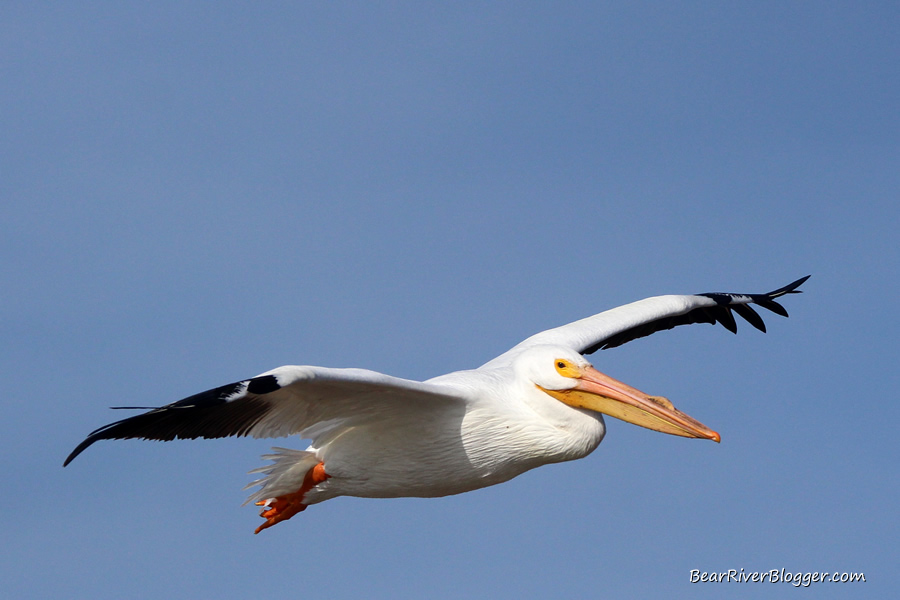If there ever was a day built for pelicans, today was indeed the day. A firm but steady wind picked up as I arrived on the Bear River Migratory Bird Refuge in search of the American white pelican to both photograph and admire on this warm spring morning.
Typically, however, wind is the arch-enemy of the outdoor photographer, but on this particular occasion, I knew it could work well for me. The wind was brisk but not overpowering, so the pelicans should be active on the nearly 80,000-acre refuge.
I love photographing pelicans in flight, especially just as these large, odd-looking birds take off from the water. Luckily, and only in this particular situation, mind you, the wind does give the avid bird photographer a brief but welcomed advantage when photographing pelicans.
It has been said the American white pelican is one of the most graceful birds in the air, riding thermals for miles with hardly a wing beat. I guess this aerial ballet set to the background music and scenery of the Bear River Migratory Bird Refuge is what compels me to come and photograph these beautiful birds over and over again each summer.
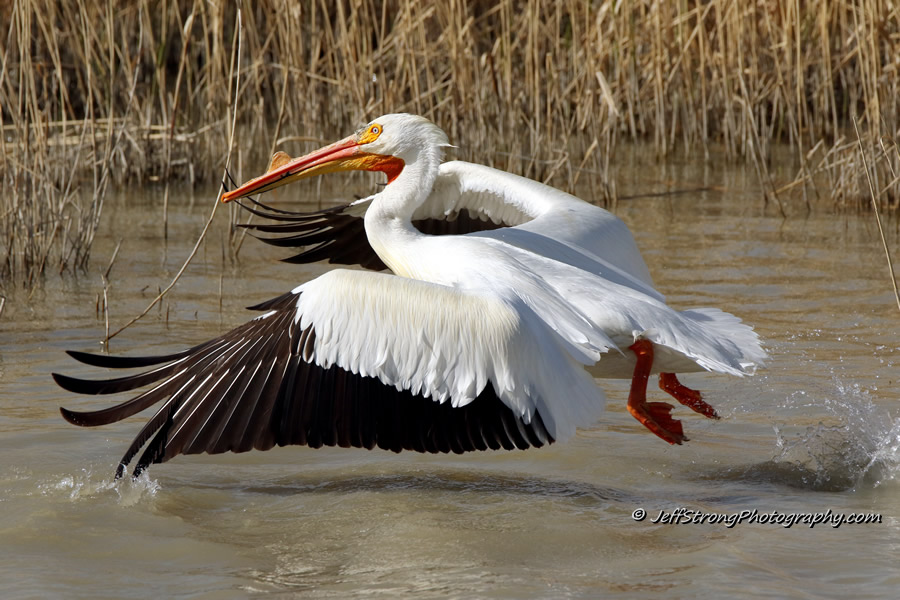
About The American White Pelican
American white pelicans can be found along wetlands, shallow lakes, and rivers in much of the central and western parts of the United States, as well as in parts of central Canada. Anywhere shallow water containing fish is found, the American white pelican can oftentimes be found also at certain times of the year.
Pelicans are a migratory bird that can fly as far north as central Canada to breed during the summer.
The bump on a white pelican’s beak is only formed in breeding adults and falls off after mating and after the birds have laid their eggs. It is not yet understood what purpose this bump has for pelicans, but it does only form during breeding season and forms on both sexes.
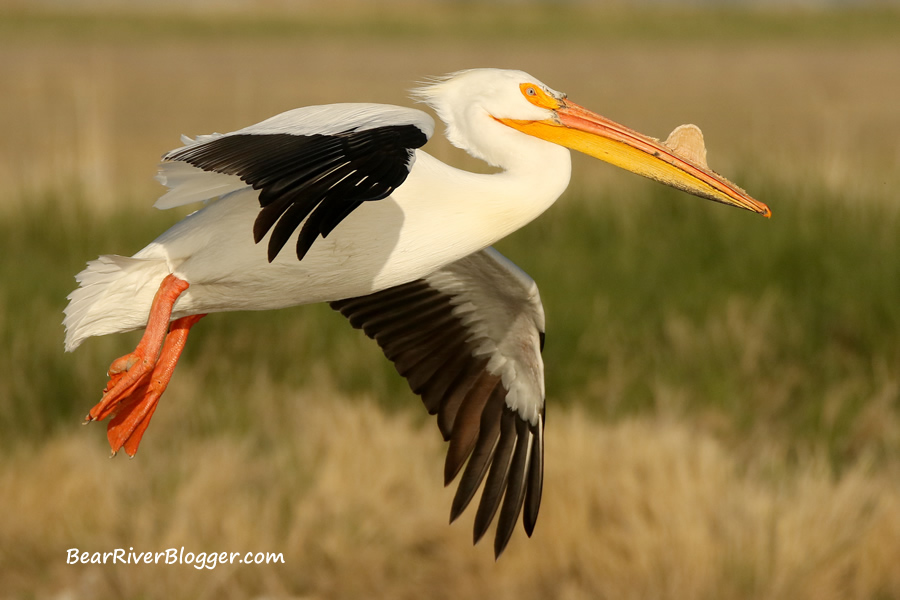
It is assumed by some that this bump might distinguish breeding maturity or even breeding availability in pelicans.
The American white pelican is one of the biggest birds in North America, second to only the California condor. The white pelican has a wingspan that reaches over 9 feet long and can weigh 10 to 30 lbs.
Fish from shallow marshes, lakes, and rivers is the main source of food for the pelican.
A group of pelicans is commonly called a pod but also referred to as a squadron, a brief, a pouch, or a scoop
Breeding Pelicans
Thousands of American white pelicans migrate to and live in Utah during the summer months, mostly along the east shore of the Great Salt Lake from the Farmington Bay WMA to the Bear River Migratory Bird Refuge. Some pelicans can be found in other areas in the state where water and fish are available.
Near the Bear River bird Refuge but remotely nestled in the middle of the north arm of the Great Salt Lake is Gunnison Island, a virtual untouched piece of land where upwards of 20,000 pelicans have been recorded to breed each summer in past years.
This small, isolated island provides a well-protected sanctuary from land borne predators, but the large-winged birds have to fly elsewhere for food.
White pelicans are colony nesters, meaning they breed and raise their young in a large group, oftentimes in a distant and secluded area away from predators and humans, such as Gunnison Island in the Great Salt Lake.
Nesting pelicans don’t build traditional nests. They use their beaks to scrape out a shallow bowl-like depression on a flat piece of ground, in either sand, gravel, or other types of soil, close to other pelicans to lay and incubate their eggs.
Although no pelicans actually nest on The Bear River Migratory Bird Refuge, it is a crucial feeding area for the Gunnison Island colony of pelicans. Great numbers of pelicans can often be found feeding in large pods on the refuge during the summer months.
Finding Pelicans
American white pelicans can be found throughout much of North America, with some going far into northern Canada to breed for the summer. During winter, white pelicans can be found along the southern coasts and even into Mexico and Central America.
The Bear River Migratory Bird Refuge is the best place to find and photograph the American white pelican. I have personally observed pods comprising of 300 or more pelicans fishing together in unison on this northern Utah bird refuge. These coordinated fishing groups of pelicans chase small fish into shallower waters where they can be more easily caught with synchronized bill dipping.
In Utah, baby pelicans are never seen due to the American white pelican colony breeding on an isolated island in the northern arm of the Great Salt Lake.
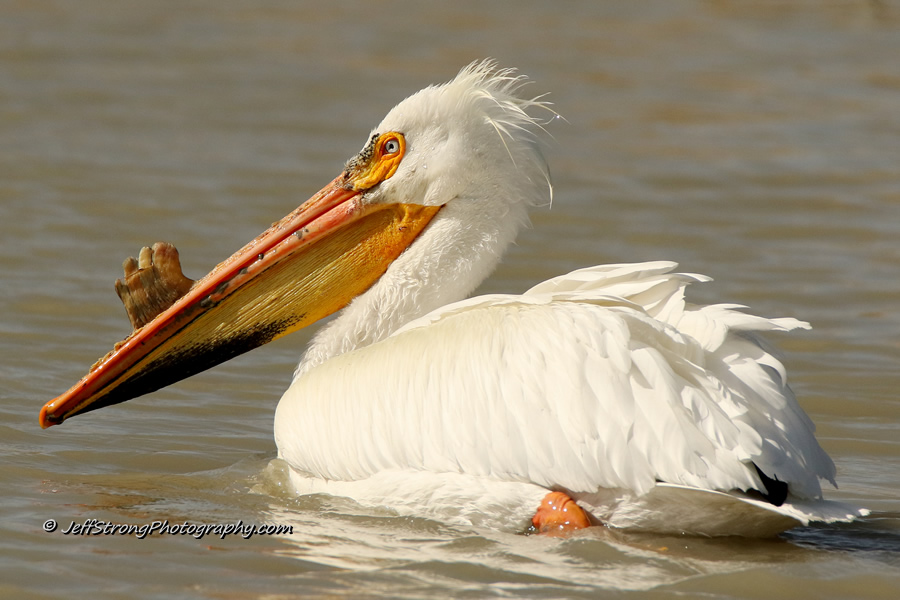
The Bear River Migratory Bird Refuge plays a vital role in the local and regional success of the American white pelican. The greater Great Salt Lake ecosystem colony of American white pelican is one of the three largest in North America. With so many pelicans needing a constant supply of fish, the refuge is vital by offering a large area to forage and rest.
It is quite a sight to behold watching pelicans take off from the refuge waters, oftentimes catching a thermal to help propel them over the dry and rugged Promontory Mountain range back to Gunnison Island to tend to their hungry chicks. I find it fascinating how these birds migrate back and forth from such a remote nesting area to the refuge each day for food.
Pelicans fly in circles to obtain lift from thermals, allowing them to easily gain altitude and soar with hardly a wingbeat. American white pelicans flying in circles is a common sight during the summer on the Bear River Migratory Bird Refuge.
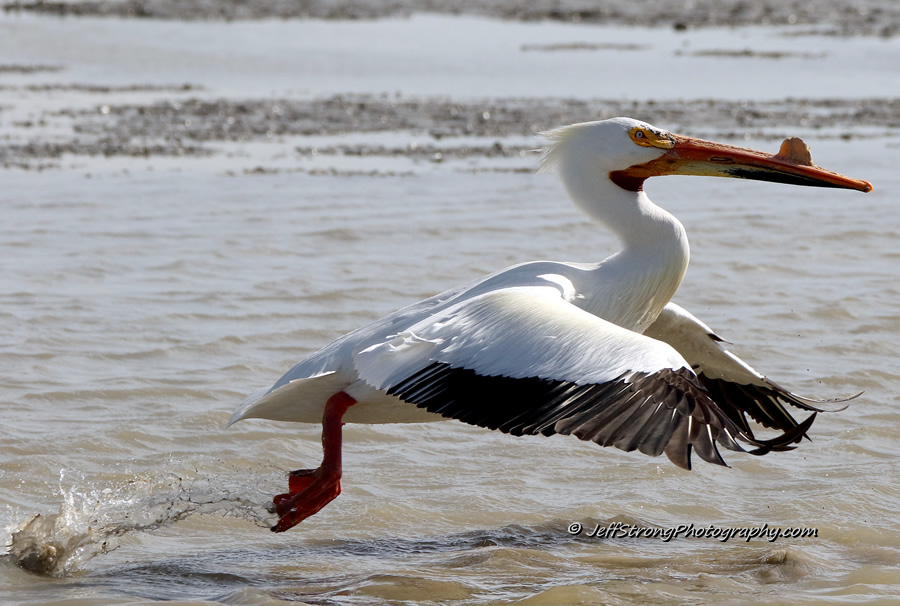
Each summer day I spend on the refuge is, in part, comprised of time in search of these beautiful birds. Pelicans are commonly found along the auto tour route, either fishing in the large open waters or loafing alongside a canal or even, at times, casually resting on the banks of the Bear River.
Pelican Migration
Watch the American white pelican long enough and you will come away with a great appreciation for the flying ability these large and very graceful birds have. Either soaring high above on a thermal or gliding just a few inches above the water, the pelican is a master of aviation in the bird world.
I am intrigued and captivated each time I observe one of these birds in flight. On land, they seem very clumsy, almost in a comical way, but in the air, there are fewer things in the natural world with such grace and beauty as a pelican soaring effortlessly for miles with hardly a wing beat.
The American white pelican is known for long migrations, with some birds flying to the northern parts of Canada during the summer to some birds flying south as far as central Mexico during the winter.
In 2014, the Utah Division of Wildlife Resources started a fascinating project aimed at catching American white pelicans and fitting them with solar-powered satellite transmitters to track their migration paths throughout the year.
As you can see from the image below, some incredible journeys have been undertaken by the American white pelican, with some migrating as far south as Mexico City and others taking a more easterly route passing through Texas.
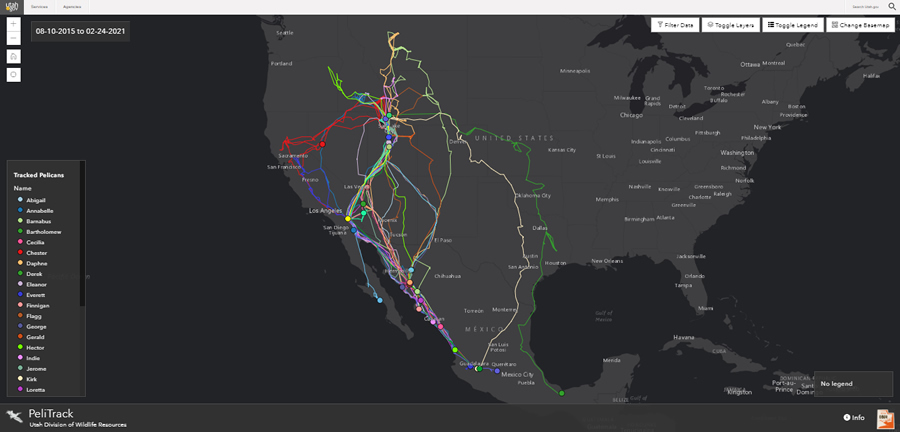
Researchers soon found out where and when these majestic birds traveled each spring and fall during migration, helping to unlock many unknown parts of the mystery of pelican migration.
Each bird not only received a transmitter but a unique name as well. The study showed that 2 of the pelicans, as just a couple of interesting examples among many, had quite different and unique migration routes.
Chester, shown below in red, took a more westerly route to California, but Bartholomew, shown in green, took a most unusual and interesting route that stretched from South Dakota to Texas and eventually flying as far south as Barrio Tabasco before ending up a bit further north near Monterrey.
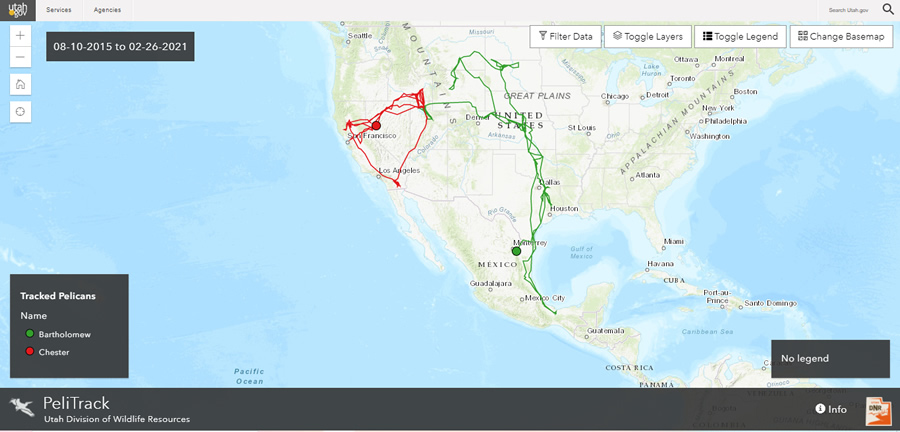
All in all, the Pelitrak website and American white pelican migration study is a great benefit and asset for anyone wanting to learn more about pelican migration routes and timing. I find it incredibly fascinating as pelicans are one of my most favorite birds to watch and photograph.
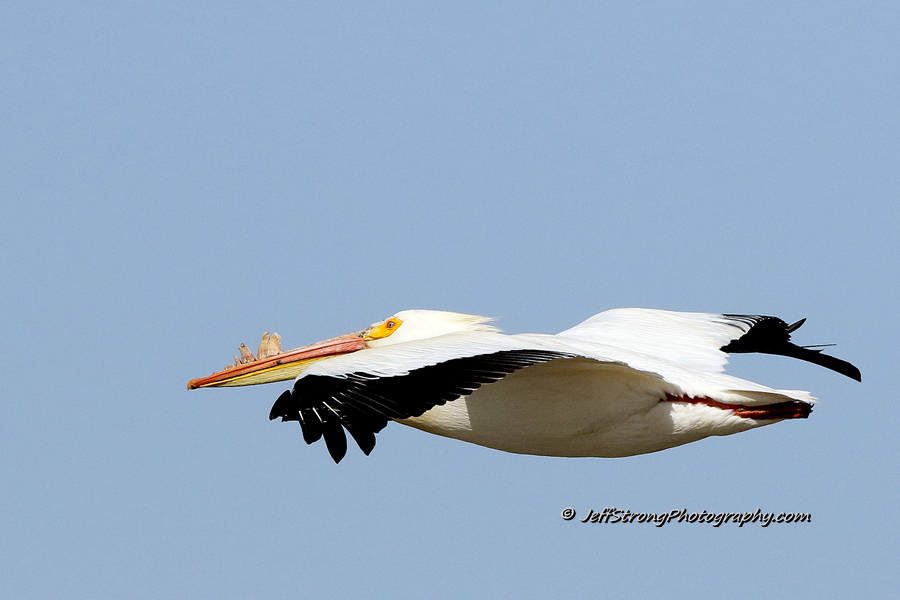
For more information about the American white pelican on the Bear River Migratory Bird Refuge, visit the refuge website and download a brief paper discussing some of the biologies of the American white pelican.
The pelican has been listed as a priority species for feeding habitat on the refuge as well. This means a portion of the nearly 80,000-acre marsh is maintained specifically for the pelican.
Subscribe to our blog
We appreciate your readership and suggest if you like this blog to head over to our subscription page and sign up for email notifications for future blog posts. We only send out emails when we post or have information about our website, and you can unsubscribe at any time.
Birding Apparel
If you’re looking for birding related gifts and apparel for someone, take a look at our online store featuring some of our own photographs turned into unique gifts.

As a reader of our blog, we offer you 20% off all products on our store by using the coupon code save20 during checkout.
Visit our Bird Shirts and More online store to check out our products. New products are constantly being added so check back often.

